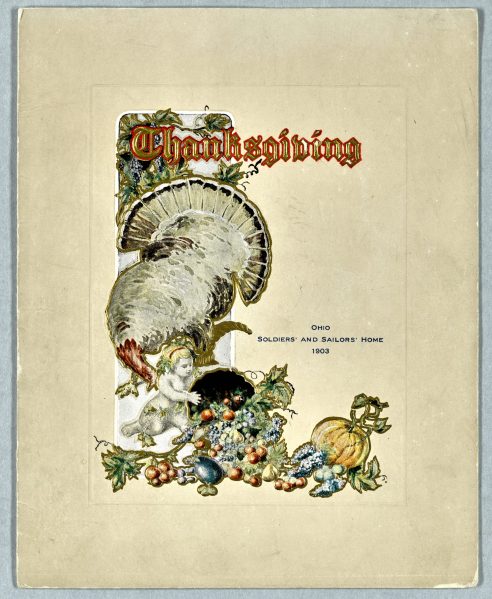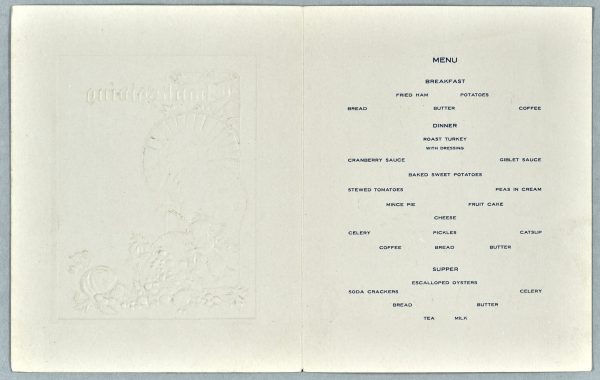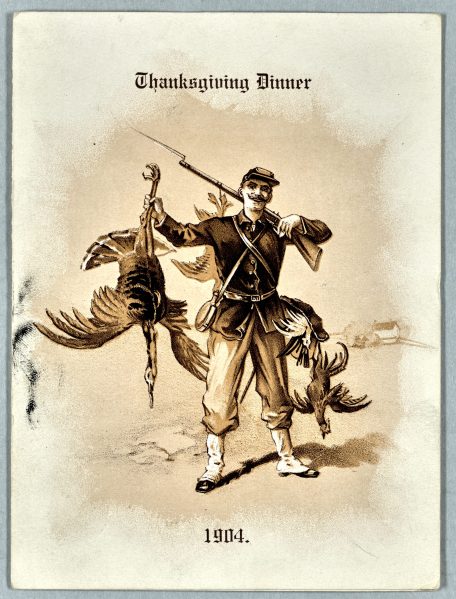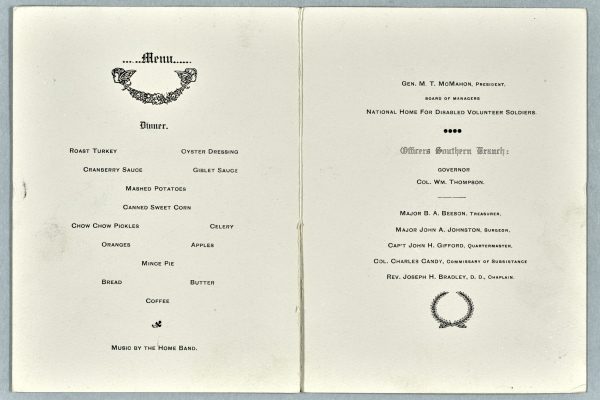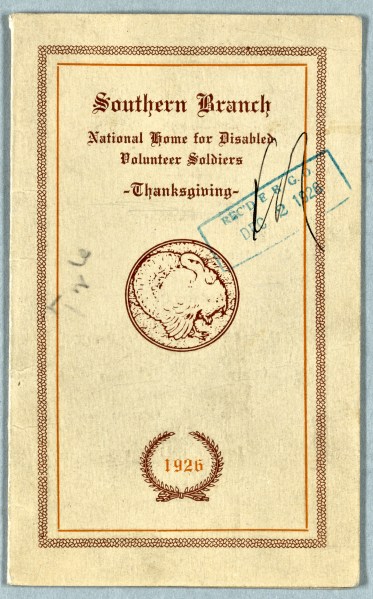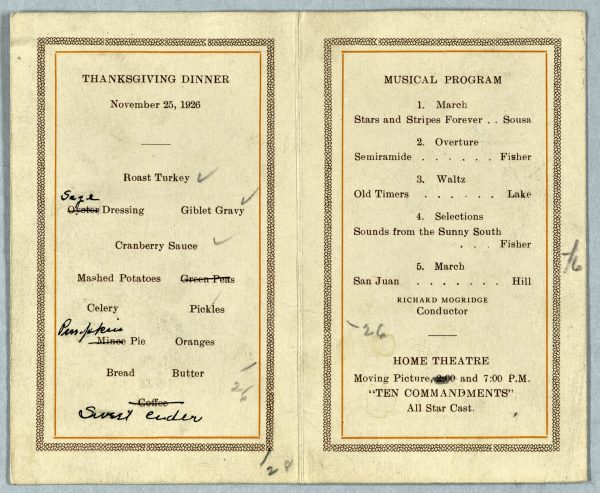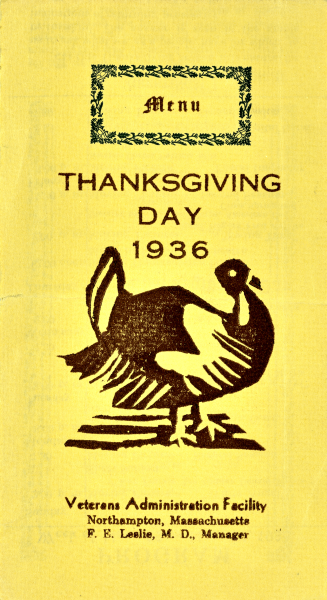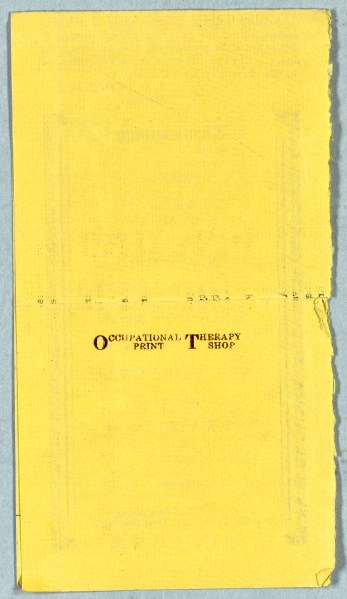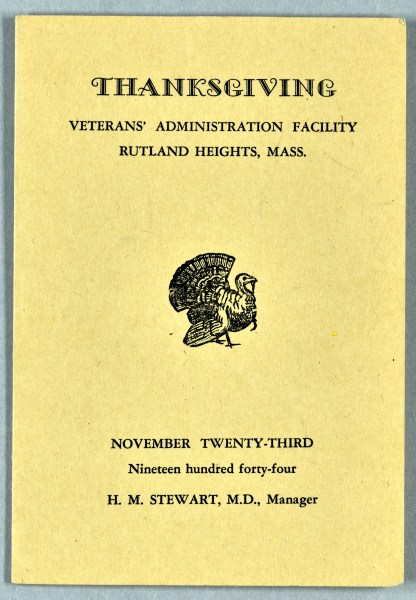In 2021, National VA History Center Archives staff wrote a little article about Thanksgiving dinner and how the meals hadn’t changed much between 1930 and 1970. At that point, we were just about six months into our collecting efforts and only had the two to compare. We are now two years into our collecting and have more to look at. The meals themselves still have consistent themes but that artwork on the covers and the small details inside are interesting. In doing the research, I learnt that these are technically not menus. Menus traditionally offer up the selection of food available, while bills of fare declare what is being served. This is reflected in J.C. Gobrecht’s book History of the National Home for Disabled Volunteer Soldiers in his description of holiday dinners.

Written in 1875 by a Veteran of the Home, it is about the most complete contemporaneous source we have on the earliest days, and we rely on it pretty frequently. Bills of fare it is.
In retired Veterans Health Administration historian Darlene Richardson’s collection, we have about 40 holiday bills of fare ranging from 1889 to about 1960. Some of them are from the various National Homes, and others are from state homes such as this one from the Ohio Soldiers’ and Sailors’ Home in Sandusky.
Not only is it complete with gold-colored paint, but when one looks inside, coffee and cigars are available for after-dinner. The cigars and Baldwin apples were sponsored items, which isn’t seen in any of the others.
This one from 1904 is interesting in the small details. On the front cover is a soldier that appears happy to have caught his dinner and is very proud of his mustache. The middle of the card shows the dinner offering as well as a list of senior staff. I did google chow chow pickles and it’s quite an easy recipe. The goal was to make sure that nothing went to waste so it’s adaptable and might be worth holding onto for canning season. The back of the card is that same soldier with a note underneath “The Advance of the Calvary Skirmish Line.” That’s one way to get out of doing the dishes.
It appears that in 1926 something went seriously awry between the printing and the actual cooking. That’s not judgement – we have all had meals go totally sideways. There is a fun story as to why my family had pepperoni pizza every year for Christmas Eve for about 12 years.
A number of the bills of fare were printed commercially, but others were printed in the occupational therapy print shops. In this next case, it’s from the VA facility in Northampton, Massachusetts, in 1936. Rather than going across like the others, they opted to go vertically as the movie schedule for the week was also printed. According to the Internet Movie Database, the facility was doing quite a decent job of keeping up with new releases.
Finally, we have an interesting one. For this menu in 1944, there are a significant developments. There is a heavy emphasis on fruits and vegetables, and also the name of the Chief Dietician, Gwendolyn E. Phipps, is in the card. The history of dietetics is tied directly to wartime consumption. The American Dietetics Association was founded in 1917 for the express purpose of helping the government conserve food and improve public health. By World War II, there were 1,580 dieticians serving, including three that were Prisoners of War in the Philippines. Several other cards list the chef or the matron, but so far this is the only one with the dietician.
We at the National VA History Center wish everyone a safe and joyful Thanksgiving!
By Robyn Rodgers
Senior Archivist, National VA History Center
Share this story
Related Stories
Curator Corner
It isn’t often that researchers who work with historic objects get to know the people who used those objects every day. Sometimes we get lucky and can link artifacts to certain facilities or buildings on a historic VA campus, but usually we must look for more hidden lines of evidence to figure out how an object fits into the history of those who care for our Nation’s Veterans. As nice as it would be, it isn’t as if many artifacts turn up labeled with their owners’ names! So, imagine my surprise when my teammates and I began sweeping Putnam Library for any historic objects left behind before the building is closed for renovation, and found just that.
As far as artifacts go, its story seemed simple: book presses like these would have been used to help maintain and repair the thousands of books read in Putnam Library ever since it first opened in 1879. The day that I first got up close and personal with the press, I noticed a woman’s name scraped into the black paint of the platen (the technical name for the big metal plate used to hold books together). It said “Helen Carson” in big, legible letters. As we carefully transported the heavy press down the many stairs inside Putnam Library, I looked at the name and thought “Hm…wonder who that is?”.
Curator Corner
Mary Lowell Putnam is tied to VA history by her generous donation of a large volume of books to the Central Branch of the National Home for Disabled Volunteer Soldiers. These books, meant to honor her son who died in the Civil War, helped foster reading advancement for the Veterans who lived there after the war and into the 20th Century. However, her life was more than just a moment in time donating books. It included a life-long study of languages and a very sharp opinion that she shared in writing throughout her life.
Curator Corner
Presidents George Washington and Abraham Lincoln are among the most easily recognizable figures in American history. Their faces are symbols of wisdom, strength, and leadership. Even today, polls consistently rank them as the greatest or most successful presidents. With that in mind, it is unsurprising that the appreciation of these legendary statesmen has deep historic roots. In honor of their birthdays, our team at the National VA History Center explored those roots through this pair of plaster busts.


